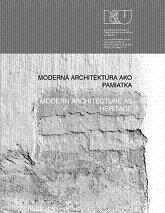TYPOLÓGIA OBJEKTOV MODERNEJ ARCHITEKTÚRY Z HĽADISKA ZACHOVANIA ICH PAMIATKOVÝCH HODNÔT PRI ZATEPĽOVANÍ
TYPOLOGY OF STRUCTURES IN MODERN ARCHITECTURE IN TERMS OF PRESERVING THEIR HERITAGE VALUE WHILE ADDING HEAT INSULATION
Author(s): Matúš DullaSubject(s): Cultural Essay, Political Essay, Societal Essay
Published by: Historický ústav SAV, v. v. i.
Keywords: modern architecture; typology; thermal insulation; façade; windows; plaster; cladding; ornament; curtain wall
Summary/Abstract: The subtleness and openness of Modernist architecture now stands in opposition to the need to conserve energy for their heating. Modernist buildings have a very specific aesthetic value, which is severely endangered by their often not being recognized as fully ‘valid’ instances of architectural heritage. For their restoration, should we wish to preserve their architectural character as much as possible, several specific problems are encountered, which often are significantly different to those found with heritage buildings of an earlier date. In terms of the restoration work, particularly for the increasing of their heat-retaining properties, it is possible to divide Modernist architectural works into a number of clear types: recognition of the specific qualities of these types allows for a better adaptation of their restoration, and a better retention of their original architectural heritage values. The current study delineates these types on examples of specific indicated works of Modernist architecture in Slovakia, and is an outcome of the larger research project ‘Modern Architecture as Monument: Energy-Conserving Restoration (APVV 0204-07)’, supported by the Slovak Research and Development Agency. Under the rubric of ‘Modernist’ architecture, we have subsumed the essential force of architectural creation (i.e. its most exemplary works) that began in the 1920s, established itself during the interwar decades as the most characteristic formal vocabulary of the age, and after World War II emerged as the all-embracing foundation for international architecture, in Europe and elsewhere around the globe. The upper time limit of our interest is set to include even those works of late Modernism that were built in the final years of state socialism during the 1980s. Our study is based on the idea that the maximum demand in dealing with the modern architectural fund is its preservation within the original parameters, including the retention of the original function and the traces of time. However, it also describes a compromise standpoint, which proportionally allows for more sizeable changes and interventions in the buildings. The basic criterion for the division of architectural objects is the extent to which the most common procedures of adding exterior heat insulation affect their heritage values. Primarily at issue here are the values represented by the building’s exterior form. This does not, however, mean that improvement of heat insulation cannot be achieved through intervention into the interior or other aspects of the building. The buildings that are the subject of our interest have been divided into five basic groupings: 1) Buildings with simple, bare facades. With some simplification, this form is regarded as the most typical segment of modern architecture, marked by simple absence of ornament and a severe appearance. Here, it is possible to draw a distinction between small buildings serving as private houses, where it could be possible to
Journal: Architektúra & Urbanizmus
- Issue Year: 44/2010
- Issue No: 3-4
- Page Range: 200-215
- Page Count: 16
- Language: Slovak

